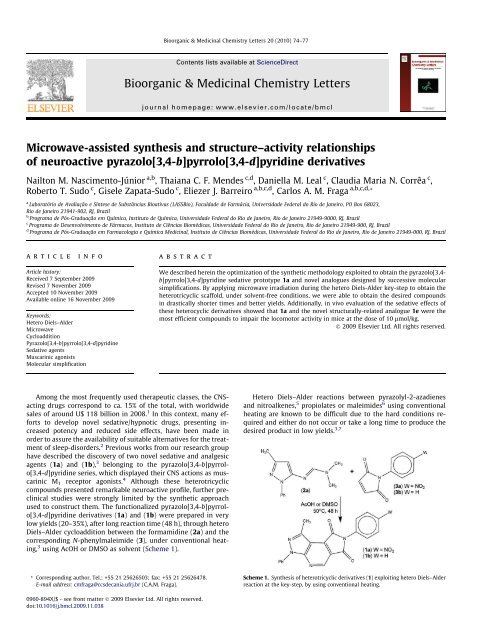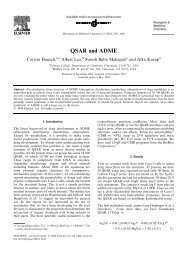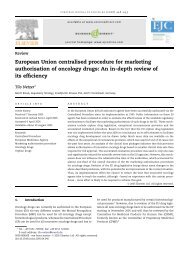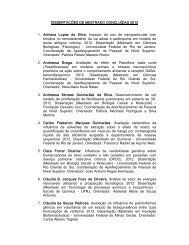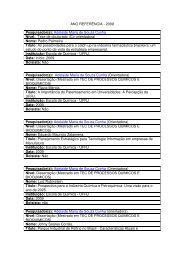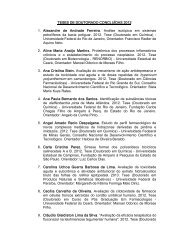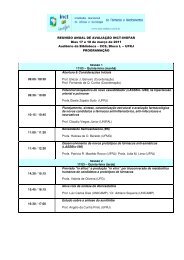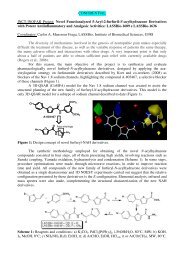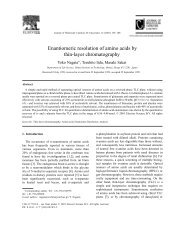Microwave-assisted synthesis and structureâactivity relationships of ...
Microwave-assisted synthesis and structureâactivity relationships of ...
Microwave-assisted synthesis and structureâactivity relationships of ...
You also want an ePaper? Increase the reach of your titles
YUMPU automatically turns print PDFs into web optimized ePapers that Google loves.
Bioorganic & Medicinal Chemistry Letters 20 (2010) 74–77<br />
Contents lists available at ScienceDirect<br />
Bioorganic & Medicinal Chemistry Letters<br />
journal homepage: www.elsevier.com/locate/bmcl<br />
<strong>Microwave</strong>-<strong>assisted</strong> <strong>synthesis</strong> <strong>and</strong> structure–activity <strong>relationships</strong><br />
<strong>of</strong> neuroactive pyrazolo[3,4-b]pyrrolo[3,4-d]pyridine derivatives<br />
Nailton M. Nascimento-Júnior a,b , Thaiana C. F. Mendes c,d , Daniella M. Leal c , Claudia Maria N. Corrêa c ,<br />
Roberto T. Sudo c , Gisele Zapata-Sudo c , Eliezer J. Barreiro a,b,c,d , Carlos A. M. Fraga a,b,c,d, *<br />
a Laboratório de Avaliação e Síntese de Substâncias Bioativas (LASSBio), Faculdade de Farmácia, Universidade Federal do Rio de Janeiro, PO Box 68023,<br />
Rio de Janeiro 21941-902, RJ, Brazil<br />
b Programa de Pós-Graduação em Química, Instituto de Química, Universidade Federal do Rio de Janeiro, Rio de Janeiro 21949-9000, RJ, Brazil<br />
c Programa de Desenvolvimento de Fármacos, Instituto de Ciências Biomédicas, Universidade Federal do Rio de Janeiro, Rio de Janeiro 21949-900, RJ, Brazil<br />
d Programa de Pós-Graduação em Farmacologia e Química Medicinal, Instituto de Ciências Biomédicas, Universidade Federal do Rio de Janeiro, Rio de Janeiro 21949-000, RJ, Brazil<br />
article<br />
info<br />
abstract<br />
Article history:<br />
Received 7 September 2009<br />
Revised 7 November 2009<br />
Accepted 10 November 2009<br />
Available online 16 November 2009<br />
Keywords:<br />
Hetero Diels–Alder<br />
<strong>Microwave</strong><br />
Cycloaddition<br />
Pyrazolo[3,4-b]pyrrolo[3,4-d]pyridine<br />
Sedative agents<br />
Muscarinic agonists<br />
Molecular simplification<br />
We described herein the optimization <strong>of</strong> the synthetic methodology exploited to obtain the pyrazolo[3,4-<br />
b]pyrrolo[3,4-d]pyridine sedative prototype 1a <strong>and</strong> novel analogues designed by successive molecular<br />
simplifications. By applying microwave irradiation during the hetero Diels-Alder key-step to obtain the<br />
heterotricyclic scaffold, under solvent-free conditions, we were able to obtain the desired compounds<br />
in drastically shorter times <strong>and</strong> better yields. Additionally, in vivo evaluation <strong>of</strong> the sedative effects <strong>of</strong><br />
these heterocyclic derivatives showed that 1a <strong>and</strong> the novel structurally-related analogue 1e were the<br />
most efficient compounds to impair the locomotor activity in mice at the dose <strong>of</strong> 10 lmol/kg.<br />
Ó 2009 Elsevier Ltd. All rights reserved.<br />
Among the most frequently used therapeutic classes, the CNSacting<br />
drugs correspond to ca. 15% <strong>of</strong> the total, with worldwide<br />
sales <strong>of</strong> around U$ 118 billion in 2008. 1 In this context, many efforts<br />
to develop novel sedative/hypnotic drugs, presenting increased<br />
potency <strong>and</strong> reduced side effects, have been made in<br />
order to assure the availability <strong>of</strong> suitable alternatives for the treatment<br />
<strong>of</strong> sleep-disorders. 2 Previous works from our research group<br />
have described the discovery <strong>of</strong> two novel sedative <strong>and</strong> analgesic<br />
agents (1a) <strong>and</strong> (1b), 3 belonging to the pyrazolo[3,4-b]pyrrolo[3,4-d]pyridine<br />
series, which displayed their CNS actions as muscarinic<br />
M 1 receptor agonists. 4 Although these heterotricyclic<br />
compounds presented remarkable neuroactive pr<strong>of</strong>ile, further preclinical<br />
studies were strongly limited by the synthetic approach<br />
used to construct them. The functionalized pyrazolo[3,4-b]pyrrolo[3,4-d]pyridine<br />
derivatives (1a) <strong>and</strong> (1b) were prepared in very<br />
low yields (20–35%), after long reaction time (48 h), through hetero<br />
Diels–Alder cycloaddition between the formamidine (2a) <strong>and</strong> the<br />
corresponding N-phenylmaleimide (3), under conventional heating,<br />
3 using AcOH or DMSO as solvent (Scheme 1).<br />
Hetero Diels–Alder reactions between pyrazolyl-2-azadienes<br />
<strong>and</strong> nitroalkenes, 5 propiolates or maleimides 6 using conventional<br />
heating are known to be difficult due to the hard conditions required<br />
<strong>and</strong> either do not occur or take a long time to produce the<br />
desired product in low yields. 3,7<br />
* Corresponding author. Tel.: +55 21 25626503; fax: +55 21 25626478.<br />
E-mail address: cmfraga@ccsdecania.ufrj.br (C.A.M. Fraga).<br />
Scheme 1. Synthesis <strong>of</strong> heterotricyclic derivatives (1) exploiting hetero Diels–Alder<br />
reaction at the key-step, by using conventional heating.<br />
0960-894X/$ - see front matter Ó 2009 Elsevier Ltd. All rights reserved.<br />
doi:10.1016/j.bmcl.2009.11.038
N. M. Nascimento-Júnior et al. / Bioorg. Med. Chem. Lett. 20 (2010) 74–77 75<br />
Figure 1. Design concept <strong>of</strong> pyrazolo[3,4-b]pyrrolo[3,4-d]pyridine derivatives <strong>of</strong> series A (1), B (4), <strong>and</strong> their simplified analogues (5) <strong>and</strong> (3a).<br />
Scheme 2. Synthesis <strong>of</strong> the functionalized N-phenyl maleimides (3a–3f) <strong>and</strong> N-<br />
phenyl azaphthlimide (5).<br />
Alternatively, the use <strong>of</strong> microwave irradiation under solventfree<br />
conditions has proved to dramatically improve the process<br />
for obtaining new heterocyclic scaffolds exploiting Diels–Alder<br />
reaction as the key-step. 5<br />
Considering this panorama, we described herein the optimization<br />
<strong>of</strong> the synthetic route to obtain the pyrazolo[3,4-b]pyrrolo[3,4-d]pyridine<br />
derivative (1a) <strong>and</strong> some previously described<br />
analogues (1b–1d) using microwave-<strong>assisted</strong> <strong>synthesis</strong> for the hetero<br />
Diels–Alder step under solvent-free conditions. Thus, we propose<br />
the enlargement <strong>of</strong> the congeneric series by the<br />
introduction <strong>of</strong> the isosteric carboxyl group <strong>and</strong> the electrondonating<br />
methoxy substituent at the W position (series A, Fig. 1).<br />
Moreover, we exploited the developed methodology to synthesize<br />
a new series <strong>of</strong> simplified heterocyclic analogues (4a–4f) designed<br />
by changing the pyrazole-attached N-phenyl by a N-<br />
methyl group in order to investigate the stereoelectronic <strong>and</strong> the<br />
lipophilic influences at this position on the sedative pr<strong>of</strong>ile <strong>of</strong> pyrazolo[3,4-b]pyrrolo[3,4-d]pyridine<br />
derivatives (Fig. 1).<br />
On the other h<strong>and</strong>, the exploitation <strong>of</strong> successive molecular<br />
simplifications on the structure <strong>of</strong> sedative prototype (1a) led us<br />
to the design <strong>of</strong> the 3-pyridinylphthalimide (5) <strong>and</strong> 4-nitrophenylmaleimide<br />
(3a) derivatives, as a result <strong>of</strong> the suppression<br />
<strong>of</strong> the pyrazole <strong>and</strong> the pyridine rings (Fig. 1). The comparative<br />
evaluation <strong>of</strong> the sedative pr<strong>of</strong>ile displayed by these heterocyclic<br />
derivatives on the locomotor activity in mice 8 provided a better<br />
underst<strong>and</strong>ing <strong>of</strong> structure–activity <strong>relationships</strong> associated with<br />
their CNS actions.<br />
Initially, the six functionalized N-phenylmaleimides (3a–3f)<br />
were prepared starting from maleic anhydride (6) <strong>and</strong> the corresponding<br />
para-substituted anilines (7).<br />
In order to obtain the desired N-phenylmaleimides (3), the different<br />
behavior <strong>of</strong> this reaction, determined by distinct solubility<br />
<strong>and</strong> nucleophilicity <strong>of</strong> the exploited anilines, was taken into consideration.<br />
Thus, only the N-phenylmaleimides (3a–3d) were prepared,<br />
in yields ranging from 63% to 83%, by refluxing a mixture<br />
<strong>of</strong> (6) <strong>and</strong> (7) in acetic acid 9 (Scheme 2). On the other h<strong>and</strong>, the attempt<br />
to prepare the unsubstituted N-phenylmaleimide (3b) <strong>and</strong><br />
the 4-carboxyphenylmaleimide (3f) under the same conditions<br />
led to the formation <strong>of</strong> the carboxy-amide intermediates (8) or<br />
(9), respectively, accompanied by other undesired subproducts.<br />
To avoid this problem, another two-step methodology was selected<br />
to prepare these two N-phenylmaleimides, using ethyl ether as solvent<br />
in the first step, followed by cyclization <strong>of</strong> the obtained carboxy-amide<br />
derivatives (8) <strong>and</strong> (9) after treatment with sodium<br />
acetate in acetic anhydride 10 (Scheme 2). Azaphthalimide derivative<br />
(5) was prepared in 23% overall yield (2 steps) through the initial<br />
condensation <strong>of</strong> 3,4-pyridinedicarboxylic anhydride (10) <strong>and</strong><br />
para-nitroaniline (7a) in acetic acid at reflux, followed by cyclization<br />
<strong>of</strong> the carboxy-amide (11) with AcONa in acetic anhydride<br />
(Scheme 2).<br />
The azadienes (2a) <strong>and</strong> (2b) were prepared as described previously,<br />
3 in almost quantitative yields through the condensation <strong>of</strong><br />
the corresponding pyrazolamines (12) or(13) <strong>and</strong> DMF dimethylacetal<br />
(14) (Scheme 3). The relative configuration (E) at imine double<br />
bond <strong>of</strong> azadienes (12) <strong>and</strong> (13) was determined by 1 H NMR,<br />
through the irradiation <strong>of</strong> the C-4 attached pyrazole hydrogen<br />
<strong>and</strong> the evidence <strong>of</strong> a NOE effect at imine hydrogen (Scheme 3).<br />
This configuration is important to assure the formation <strong>of</strong> hetero<br />
Diels–Alder adduct presenting antiperiplanar orientation between<br />
the N,N-dimethylamino group <strong>and</strong> the vicinal hydrogen able to
76 N. M. Nascimento-Júnior et al. / Bioorg. Med. Chem. Lett. 20 (2010) 74–77<br />
Scheme 3. Synthesis <strong>of</strong> pyrazolo[3,4-b]pyrrolo[3,4-d]pyridine derivatives (1a–1f) <strong>and</strong> (4a–4f) exploiting hetero Diels–Alder reaction under microwave irradiation in solventfree<br />
conditions.<br />
produce the desired heterocyclic derivatives (1) <strong>and</strong> (4) after elimination<br />
<strong>and</strong> oxidative aromatization steps. 7<br />
Next, in order to optimize the hetero Diels-Alder key-step we<br />
proceeded to the investigation <strong>of</strong> cycloaddition between (2a) <strong>and</strong><br />
(3a) under microwave irradiation <strong>and</strong> solvent-free conditions,<br />
starting with 80 W, at 50 °C for 30 min.<br />
The microwave tube used was exposed to atmospheric oxygen<br />
throughout the experiments to favor the oxidative aromatization<br />
step after Diels–Alder adduct formation. 7 Besides these initial conditions,<br />
the temperature was systematically increased from 50 to<br />
60, 70, 80 <strong>and</strong> 90 °C, but (1a) was obtained in highest yield (35%)<br />
at 80 °C. When the temperature was 90 °C <strong>and</strong>/or the power was<br />
changed to 90 W, degradation <strong>of</strong> (4) was detected by TLC. After setting<br />
the power to 80 W, the temperature at 80 °C <strong>and</strong> extending<br />
the time <strong>of</strong> the reaction to 60, 90 <strong>and</strong> 120 min, (1a) was obtained<br />
in 50%, 80% <strong>and</strong> 75% yields, respectively, after work-up by washing<br />
with warm MeOH (ca. 60 °C). All other heterocyclic derivatives <strong>of</strong><br />
series A (1b–1f) <strong>and</strong> B (4a–4f) were synthesized following the<br />
same methodology (80 W, 80 °C, 90 min., Scheme 3) <strong>and</strong> their<br />
structures are in agreement with analytical <strong>and</strong> spectral data.<br />
The sedation produced by derivatives (1a–1f), (4a–4f) <strong>and</strong> simplified<br />
analogues (5) <strong>and</strong> (3a) was investigated using locomotor<br />
activity test in mice 8 (Table 1). The intraperitoneal administration<br />
<strong>of</strong> a screening dose <strong>of</strong> 10 lmol/kg for all these compounds revealed<br />
that para-nitro derivative (1a) <strong>and</strong> the novel para-methoxy derivative<br />
(1e), both from series A, presented the highest sedative<br />
activity, being able to reduce the number <strong>of</strong> movements/minute<br />
<strong>of</strong> treated animals from 214.4 ± 18.9 to 87.6 ± 16.2 * <strong>and</strong><br />
108.6 ± 14.9 * mov/min., respectively. These values are statistically<br />
equivalent to the reference drug, midazolam (Table 1). Even<br />
though the nitro <strong>and</strong> the methoxy groups at the W position<br />
( Fig. 1) exhibit different electronic characteristics, compounds<br />
(1a) <strong>and</strong> (1e) did not present significant differences in sedative<br />
activity probably due to the capability <strong>of</strong> these two groups, potential<br />
pharmacophoric points, to be recognized as H-bond acceptors<br />
with complementary residues <strong>of</strong> occasional target bioreceptors.<br />
This interaction seems to be essential for the effect investigated,<br />
once the corresponding unsubstituted compound (1b) <strong>and</strong> the<br />
two para-substituted derivatives (1c) <strong>and</strong> (1d) were not able to affect<br />
significantly the motor activity in animals. An exception to this<br />
behavior was observed in carboxyl derivative (1f), which did not<br />
impair the locomotor activity in animals, probably due to pharmacokinetic<br />
factors resulting from its ionization in vivo. As evidenced<br />
for compound (1a), the CNS effects <strong>of</strong> (1e) were reversed by the<br />
pre-treatment <strong>of</strong> animals with atropine, indicating that it could<br />
also act as a muscarinic agonist. 4<br />
Table 1<br />
Effects <strong>of</strong> midazolam, pyrazolo[3,4-b]pyrrolo[3,4-d]pyridine derivatives (1a–1f), (4a–<br />
4f) <strong>and</strong> the simplified analogues 5 <strong>and</strong> 3a on the locomotor activity in mice 8<br />
Compound Series Motor activity a (mov/min)<br />
Control — 214.4 ± 18.9<br />
Midazolam b — 79.7 ± 25.1 *<br />
1a A 87.6 ± 16.2 *<br />
1b A 266.6 ± 30.6<br />
1c A 154.3 ± 24.3<br />
1d A 161.7 ± 29.2<br />
1e A 108.6 ± 14.9 *<br />
1f A 174.2 ± 21.8<br />
4a B 141.0 ± 25.8<br />
4b B 208.6 ± 11.4<br />
4c B 133.4 ± 16.3<br />
4d B 187.4 ± 23.0<br />
4e B 150.6 ± 15.7<br />
4f B 128.3 ± 20.6<br />
5 — 189.0 ± 16.76<br />
3a — 148.0 ± 13.85<br />
a<br />
All derivatives were administered ip (10 lmol/kg) <strong>and</strong> motor activity was<br />
determined during 40 min after injection. Data are expressed as means <strong>of</strong> the<br />
movements per minute ± SEM.<br />
b Administered at the dose <strong>of</strong> 2 mg/kg.<br />
* P
N. M. Nascimento-Júnior et al. / Bioorg. Med. Chem. Lett. 20 (2010) 74–77 77<br />
simplification study confirmed that almost all the subunits present<br />
in the structure <strong>of</strong> derivatives <strong>of</strong> series A are crucial to promote the<br />
sedative effect, as it was observed for derivative 1a <strong>and</strong> the novel<br />
analogue 1e. Taking together, these results make the multigram<br />
<strong>synthesis</strong> <strong>of</strong> prototype 1a <strong>and</strong> its analogues possible, enabling the<br />
next steps towards the development <strong>of</strong> these heterotricyclic derivatives<br />
into innovative sedative agents.<br />
Acknowledgments<br />
The authors thank CAPES (BR), CNPq (BR), FAPERJ (BR), PRONEX<br />
(BR) <strong>and</strong> INCT-INOFAR (BR, #573.564/2008-6) for financial support<br />
<strong>and</strong> fellowships.<br />
Supplementary data<br />
Supplementary data associated with this article can be found, in<br />
the online version, at doi:10.1016/j.bmcl.2009.11.038.<br />
References <strong>and</strong> notes<br />
1. http://knol.google.com/k/krishan-maggon/global-brain-drugs-market-review-<br />
2008/3fy5eowy8suq3/1#<br />
2. Korzh, M. Sleep Med. 2007, 8, 578.<br />
3. Menegatti, R.; Silva, G. M. S.; Zapata-Sudo, G.; Raimundo, J. M.; Sudo, R. T.;<br />
Barreiro, E. J.; Fraga, C. A. M. Bioorg. Med. Chem. 2006, 14, 632.<br />
4. Mendes, T. C. F.; Raimundo, J. M.; Nascimento, N. M., Jr.; Fraga, C. A. M.;<br />
Barreiro, E. J.; Zapata-Sudo, G. Pharmacol. Biochem. Behav. 2009, 94, 70.<br />
5. (a) Díaz-Ortiz, A.; Carrilo, J. R.; Gómez-Escalonilla, M. J.; de la Hoz, A.; Moreno,<br />
A.; Prieto, P. Synlett 1998, 1069; (b) Díaz-Ortiz, A.; Carrilo, J. R.; Cossio, F. P.;<br />
Gómez-Escalonilla, M. J.; de la Hoz, A.; Moreno, A.; Prieto, P. Tetrahedron 2000,<br />
56, 1569.<br />
6. Díaz-Ortiz, A.; de La Hoz, A.; Langam, F. Green Chem. 2000, 2, 165.<br />
7. Mason, H. J.; Wu, X.; Schmitt, R.; Macor, J. E.; Yu, G. Tetrahedron Lett. 2001, 42,<br />
8931.<br />
8. Mara, S.; Diaz-Veliz, G.; Lungenstrass, H.; Garcia-Gonzalez, M.; Coto-Morales,<br />
T.; Poletti, C.; De Lima, T. C. M.; Herrera-Ruiz, M.; Tortoriello, J. J.<br />
Ethnopharmacol. 2005, 97, 191.<br />
9. Lima, L. M.; Barreiro, E. J.; Fraga, C. A. M. Synth. Commun. 2000, 30, 3291.<br />
10. Cava, M. P.; Deana, A. A.; Muth, K.; Mitchell, A. J. Org. Synth. Coll. 1973,<br />
5, 944.


